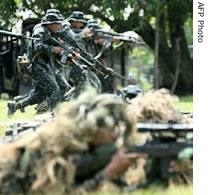2007年VOA标准英语-Philippine Marines on Front Line in War on Terr(在线收听)
Jolo
20 February 2007
The Philippines has recently been on the front line in the war on terror, taking out top leaders of the deadly Abu Sayyaf Islamic militant group, which has links with the regional terrorist group Jemaah Islamiah. Douglas Bakshian recently traveled to the southern Philippine island of Jolo where about 5,000 Philippine soldiers, Marines and other forces are hunting down the Abu Sayyaf. He joined the Marines on a jungle patrol.

A special operations platoon of the Philippine Marine Battalion Landing Team conduct a military exercise in Jolo, 05 Feb 2007
A radio cuts through the silence, as a Philippine Marine checks with his advance guard. In territory once occupied by the Abu Sayyaf, the Marines take no chances, and in the jungles of Jolo, the suspense is thicker than the vegetation.
The patrol moves through an area [Patikul] only four kilometers from the town of Jolo, where the Abu Sayyaf camp was located just months ago. It was the scene of a bloody encounter in which the group's leader was killed.
In the early hours of September 4, a Philippine Marine reconnaissance unit of 27 men made contact with the enemy, and the jungle turned into a shooting gallery.
First Lieutenant Marvin Salvan was on a back-up patrol near the battle scene. Although his unit was not directly involved in the fighting, his memory is vivid.
"At about 5 a.m., the fire light already started. At that time our troops [the reconnaissance unit] started to throw grenades and then started to have their volume of fire sir, directed to the enemy positions," he said. "But the enemy is too many for them."
The Marines faced more than 100 guerrillas. After a two-hour fire light six Marines had been killed and many wounded.
The Abu Sayyaf casualties are not known because the group carries its dead away. But months later the Marines confirmed that they had killed leader Khaddafy Janjalani after a guerrilla defector led them to his jungle grave.
He was one of two Abu Sayyaf leaders to be eliminated in recent months. In January, Abu Sulaiman, a key planner, was killed. He claimed responsibility for a 2004 ferry bombing in which more than 100 people died.
Those successes are part of a new strategy of targeting terrorist leaders. These are selective actions, based on specific intelligence, rather than older tactics of large sweeps using many soldiers.
Abu Sayyaf says it is fighting for an Islamic homeland in the region known as Mindanao in the southern Philippines, which is mostly Catholic. The group has links with Jemaah Islamiah, an Islamic terrorist organization based in Indonesia. However, Abu Sayyaf is best known for its deadly kidnappings to earn ransom.
Marine General Juancho Sabban, commander of the Third Philippine Marine Brigade on Jolo, says as the leadership is destroyed, the Abu Sayyaf will fall apart.
"Mindanao is composed of so many tribes and not all of them can be at one place at the same time," he explained. "So it will take a good leader to really unite them. Right now with the death of Janjalani and Sulaiman, those coming from Basilan, who belong to Yakan tribe, will try to go back to Basilan because they will be afraid to stay here surrounded by a different tribe."
The Marines had learned about the Jolo camp through an informer. They say human intelligence is increasingly important in hunting the group.
Technical intelligence makes a big contribution as well. Marine anti-terror missions are mostly conducted at night, with the assistance of night-vision goggles from the United States.
Another technical edge comes from the U.S. military in the form of reconnaissance aircraft.
"We have an airplane with a camera. And in a basic sense the Philippine forces might say, 'What's on the other side of that tree line? [And the U.S. forces might say] Fire and brimstone. [Danger] Don't go there,'" said U.S. Navy Commander James Marvin, the deputy commander of the Joint Special Operations Task Force-Philippines.
A few hundred U.S. troops advise and train the Philippine forces, but do not take part in fighting.
Hunting down terrorists on land is not enough in the Philippines, they also must be fought at sea. The thousands of islands in this part of Southeast Asia have provided an escape route for Abu Sayyaf guerrillas in the past. They were able to move to other Philippine islands or even to neighboring Malaysia. But the Philippine Navy is closing the noose on the terrorists, with more efficient patrols around Jolo.
Military officials say that since August, when Operation Ultimatum, the current offensive against Abu Sayyaf began, the navy has inspected at least 5,000 vessels. Before it only stopped 1,000 a year. The expanded program has been conducted through training exercises with the elite U.S. Navy Seals and their vessels.
Philippine military officials estimate 200 Abu Sayyaf fighters may be left on Jolo, with 150 others scattered in the region. They say almost 70 militants have been killed and about two dozen were captured or defected since Operation Ultimatum began.